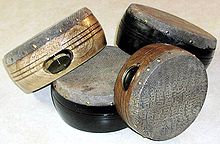Tambourine: Difference between revisions
Removed an unverified quote. |
Rochelimit (talk | contribs) →Timbrel: added rebana |
||
| Line 72: | Line 72: | ||
[[File:Deff - Tambourine, p. 579 in Thomson, 1859.jpg|thumb|Deff - Tambourine, Palestine, picture p. 579 in W. M. Thomson: The Land and the Book; or Biblical Illustrations Drawn from the Manners and Customs, the Scenes and Scenery of the Holy Land. Vol. II. New York, 1859.]] |
[[File:Deff - Tambourine, p. 579 in Thomson, 1859.jpg|thumb|Deff - Tambourine, Palestine, picture p. 579 in W. M. Thomson: The Land and the Book; or Biblical Illustrations Drawn from the Manners and Customs, the Scenes and Scenery of the Holy Land. Vol. II. New York, 1859.]] |
||
'''Timbrel''' or '''tabret''' (the ''tof'' of the ancient [[Hebrews]], the ''deff'' of [[Islam]], the ''adufe'' of the Moors of [[Spain]]), the principal musical instrument of percussion of the [[Israelites]], similar to the modern tambourine. |
'''Timbrel''' or '''tabret''' (the ''tof'' of the ancient [[Hebrews]], the ''deff'' of [[Islam]], the ''adufe'' of the Moors of [[Spain]]), the principal musical instrument of percussion of the [[Israelites]], similar to the modern tambourine. |
||
==Rebana== |
|||
{{Main|Rebana}} |
|||
'''Rebana''' is a Malay [[tambourine]] that is used in Islamic devotional music in Southeast Asia, particularly in [[Indonesia]], [[Malaysia]], [[Brunei]], and [[Singapore]]. |
|||
==See also== |
==See also== |
||
Revision as of 14:07, 20 January 2011
| File:Pandei inter.jpg Tambourine (interior view) | |
| Percussion instrument | |
|---|---|
| Other names | Riq, Buben |
| Classification | hand percussion |
| Hornbostel–Sachs classification | 112.122(+211.311, with drumhead) (Indirectly struck idiophone, sometimes including struck membranophone) |
| Playing range | |
| High sound of jingles, plus some have a skin with a lower sound. | |
| Related instruments | |
| Riq, Buben, Dayereh, Daf, Kanjira, Frame drum | |

The tambourine or marine (commonly called tambo) is a musical instrument of the percussion family consisting of a frame, often of wood or plastic, with pairs of small metal jingles, called "zils". Classically the term tambourine denotes an instrument with a drumhead, though some variants may not have a head at all. Tamborines are often used with regular percussion sets. They can be mounted, but position is largely down to preference.
Tambourines come in many different shapes with the most common being circular. It is found in many forms of music, Italian folk music, classical music, Roma music, Persian music, gospel music, pop music and rock music. The word tambourine finds its origins in French tambourin, which referred to a long narrow drum used in Provence, the word being a diminutive of tambour "drum," altered by influence of Arabic tunbur "drum".[1], from the Middle Persian word tambūr "lute, drum".[2]
Playing
The tambourine can be held in the hand or mounted on a stand, and can be played in numerous ways, from stroking or shaking the jingles to striking it sharply with hand or stick or using the tambourine to strike the leg or hip. A less common way to play a tambourine is with the inches.
Tambourine rolls
There are several ways to achieve a tambourine roll. Contrary to the common misconception, the easiest method is to rapidly rotate the hand holding the tambourine back and forth, pivoting at the wrist, not by literally rolling the tambourine down a sloped surface (for example a hill).
Thumb roll
An advanced playing technique is known as the thumb roll. The finger or thumb is moved over the skin or rim of the tambourine, producing a fast roll from the jingles on the instrument. This takes more skill and experience to master.
The thumb of the hand not holding the tambourine is run around the head of the instrument approximately one centimeter from the rim with some pressure applied. If performed correctly, the thumb should bounce along the head rapidly, producing the roll.
The thumb roll technique can be made easier with the application of wax or resin to the head. A continuous roll can be achieved by moving the thumb in a figure of 8 pattern around the head. of stuff
Pandeiro
Originated in Portugal, the pandeiro was brought to Brazil by the Portuguese settlers. It is a hand percussion instrument consisting of a single tension-headed drum with jingles in the frame. It is very typical of more traditional brazilian music
Panderoa
The Basque pandero is a folk instrument currently played along with the diatonic accordion in a duo most of the times. Sometimes the players, who play in festivities to enliven the atmosphere or less frequently at onstage performances, sing along. At times the pandero accompanies the alboka or txistu too. Yet this kind of duos have not always been the case. As attested in 1923, the youth gathered to dance to the rhythm of the bare pandero, with no other music instrument implicated but the player's (a woman's) voice.
Riq

The riq (also spelled riqq or rik) is a type of tambourine used as a traditional instrument in Arabic music. It is an important instrument in both folk and classical music throughout the Arabic-speaking world. Widely known as "Shakers".
Buben
Buben (Бубен in Russian, Бубон in Ukrainian, boben in Slovenian, buben in Czech, bęben in Polish) is a musical instrument of the percussion family similar to a tambourine. A buben consists of a wooden or metal hoop with a tight membrane stretched over one of its sides (some bubens have no membrane at all). Certain kinds of bubens are equipped with clanking metal rings, plates, cymbals, or little bells. It is held in the hand and can be played in numerous ways, from stroking or shaking the jingles to striking it sharply with hand. It is used for rhythmical accompaniment during dances, soloist or choral singing. Buben is often used by some folk and professional bands, as well as orchestras.
The name is related to Greek language βόμβος (low and hollow sound) and βομβύλη (a breed of bees) and related to Indo-Aryan bambharas (bee) and English bee.
Buben is known to have existed in many countries since time immemorial, especially in the East. There are many kinds of bubens, including def, daf, or qaval (Azerbaijan), daf or khaval (Armenia), daira (Georgia), doira (Uzbekistan and Tajikistan), daire or def (Iran), bendeir (Arab countries), pandero (Spain). In Kievan Rus, drums and military timpani were referred to as buben.
Dayereh

A dayereh (or doyra, dojra, dajre, doira, daire) is a medium-sized frame drum with jingles used to accompany both popular and classical music in Iran (Persia), the Balkans, and many central Asian countries such as Tajikistan and Uzbekistan. It is a percussion instrument, and is something intermediate between a drum and a tambourine.
Daf

A daf is a large-sized tambourine used to accompany both popular and classical music in Iran, Azerbaijan, Turkey (where it is called tef), Uzbekistan (where it's called childirma), India (where it is known as the Dafli) Turkmenistan, and Iranian Kurdistan. Daf typically indicates the beat and tempo of the music being played, thus acts like the conductor in the monophonic oriental music. The Persian poet Rudaki, who widely used names of the musical instruments in his poems, mentions the daf and the tambourine (taboorak) in a Ruba'i:
Kanjira

The kanjira or ganjira is a South Indian frame drum of the tambourine family. It is mostly used in Carnatic music concerts (South Indian classical music) as a supporting instrument for the mridangam.
Timbrel

Timbrel or tabret (the tof of the ancient Hebrews, the deff of Islam, the adufe of the Moors of Spain), the principal musical instrument of percussion of the Israelites, similar to the modern tambourine.
Rebana
Rebana is a Malay tambourine that is used in Islamic devotional music in Southeast Asia, particularly in Indonesia, Malaysia, Brunei, and Singapore.
See also

References
External links
- Watch a video "how to play a half moon tambourine"
- Chisholm, Hugh, ed. (1911). Encyclopædia Britannica (11th ed.). Cambridge University Press.
{{cite encyclopedia}}: Missing or empty|title=(help)
- Idiophones
- Membranophones
- Orchestral percussion
- Drum kit components
- Russian music
- Macedonian music
- Greek music
- Turkish musical instruments
- Indian musical instruments
- Marching percussion
- Percussion instruments
- Early musical instruments
- Russian folk music
- Ukrainian musical instruments
- Belarusian musical instruments
- Bosnian musical instruments
- Latin percussion
- Hungarian musical instruments
- Tajik musical instruments
- Portuguese musical instruments
- Sakha musical instruments
- Slovenian musical instruments
- Czech musical instruments
- Polish musical instruments
- Macedonian musical instruments
- Ancient Egyptian musical instruments

